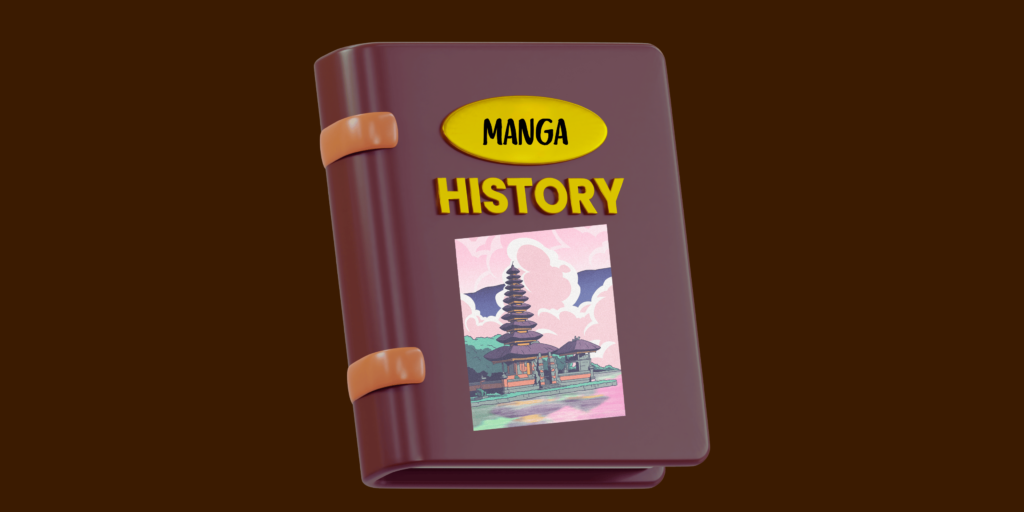Manga has gone from being a niche interest to a mainstream hobby in the past few years. These comics are known for their ability to tell stories in an artistically sophisticated manner while still tugging the reader’s heartstrings.
Manga is always printed in black and white, and the art style has certain unique characteristics that make it instantly recognizable. It spans several genres: action, fantasy, thriller, romance, and coming-of-age. Manga is also a source for anime adaptations, as most popular manga are turned into anime.
Also Read: How to read Manga correctly
While it may seem like a new phenomenon, manga as an art form has a long history in Japan. Read this article to learn more about the history and origin of manga comics.
Contents
Manga Before World War II
The art of manga is believed to originate from scroll works dating back to the 12th century. However, the word manga itself came into common usage only in the late 18th to early 19th centuries with the publication of Santo Kyoden’s Shiji no yukikai and Aikawa Minwa’s Manga hyakujo.
Kitazawa Rakuten was the first artist to use the term in the modern sense to refer to speech-balloon-based comics. His Jiji Manga debuted in 1900, and he began the first modern Japanese comic strip in 1902. As the 1930s rolled around, comic strips started being serialized in monthly boys’ and girls’ magazines and were collected into hardback volumes.
Manga After World War II
Japanese manga artists grew into their style during the occupation and post-occupation years as the country rebuilt its political and economic infrastructure. The 1947 Japanese Constitution also prohibited all forms of censorship, further fuelling artistic creativity.
Osamu Tezuka’s Astro Boy and Machiko Hasegawa’s Sazae-san are two influential and iconic works from this era.
Astro Boy had a deeply developed conscience and represented a Japanese sociality and community-oriented masculinity that was in direct contrast to the Emperor-worship and militaristic obedience promoted during the period of Japanese imperialism.
Sazae-san, on the other hand, followed a young woman artist as she dealt with her family and the situations around her. She is a strong character and is a stand-in for all the Japanese women in the post-war years.
Again, her resilience and bold nature are in contrast to the neo-Confucian principles of feminine meekness and obedience encouraged during the military regime. Sazae-san’s focus on daily life and women’s experiences laid the groundwork for future shojo works.
The Rise of Shojo Manga
The two main marketing genres for manga- shojo and shonen had solidified in the 1950s and 1960s. However, the turning point for the shojo genre was in 1969 when several women manga artists, such as Hagio Moto, Riyoko Ikeda, Yumiko Oshima, and Ryoko Yamagishi, made their debut.
This was the first major entry of women artists into the manga world, and subsequently, shojo manga was primarily drawn by women for an audience of girls and young women. These works often challenged Japan’s neo-confucianist limitations on women’s personalities and activities.
Shojo developed stylistically and developed subgenres in the following decades. Love, intense narratives of self-realization, and coming-of-age are common themes in such manga. Stories with superheroines such as Sailor Moon and Magic Knight Rayearth continued to challenge Japanese norms on women’s roles and activities.
As the girls who read shojo manga matured by the 1980s, artists started experimenting with new subgenres to fit the tastes of a changing audience. This led to the development of josei as a manga genre. Josei was aimed at women over the age of 18 years and dealt with themes of young adulthood, i.e., jobs, problems of sexual intercourse, and the love and friendship between women.
The Appeal of Gekiga
Gekiga is a manga style that is aimed at an adult audience. It features mature themes and a more cinematic art style. Stories in this genre tend to be emotionally dark, often extremely violent, and have a gritty art style as they explore the realities of day-to-day life.
Gekiga is believed to trace its origins partly from the working-class and left-wing political activism of the 1950s and 1960s and partly from the aesthetic dissatisfaction of artists like Yoshihiro Tatsumi with the existing manga style.
Some examples of Gekiga manga are Sanpei Shirato’s Chronicles of a Ninja’s Military Accomplishments and Hiroshi Hirata’s Satsuma Gishiden.
The subgenre started shifting towards socially conscious and mature drama with a sprinkling of avant-garde as the social protest of the earlier eras began waning. Osamu Tezuka’s MW and Ira Ishida and Sena Arito’s Ikebukuro West Gate Park are some examples of later Gekiga works.
Meaning of Manga Genre Types
Shonen
The target audience for shonen manga are tween and teen boys aged 10 to 18. These stories usually feature a young male protagonist, focusing on adventure, friendship, action, and battle themes. Comedy is pretty much always there in shonen manga, and they tend to have plenty of action sequences as well.
Weekly Shonen Jump is perhaps the most popular magazine in this genre and has published some of the most popular series in the last 30 years, including the Dragon Ball series by Akira Toriyama, Masashi Kishimoto’s Naruto, and as well as newer hits like My Hero Academia.
Shojo
The shojo manga genre is aimed at tween and teen girls between the ages of 10 and 18. These manga are less about action and focus more on drama and emotion. Romance, familial relationships, and coming-of-age are themes commonly found in stories marked as shojo. This manga category is easy to identify due to the liberal use of bright colors, flowers, and cute images on their covers.
Naoko Takeuchi’s Sailor Moon is the best example of a popular shojo series. The manga follows 14-year-old Usagi Tsukino, who discovers she is the reincarnation of the legendary Sailor Moon. After this revelation, she sets out with her fellow Sailor Scouts to defend Earth from the forces of evil in the name of the Moon.
However, assuming that shojo is all about cute and fun stories would be erroneous. Nana by Ai Yazawa is, for example, tagged as shojo because it was first published in a shojo magazine. However, it tackles several mature themes, such as personal and sexual relationships and drug use, as the two protagonists try to fulfill their dreams.
Seinen
Seinen manga is the adult version of shonen and is targeted at adult men over the age of 18. This simply means that manga marked as seinen can be expected to have a darker and more serious tone than shonen and often feature foul language, graphic violence, and sexual and other adult content. More often than not, these are dark, gritty tales with an older male protagonist.
Seinen protagonists usually have a more realistic take on life, unlike the idealism of their shonen counterparts. It is also not at all necessary here that the hero will save the day.
Akira by Katsuhiro Otomo is the most famous example of a seinen manga. It follows the leader of a biker gang, Shotaro Kaneda, a revolutionary militant Kei, an ESP trio, and the military leader Shikishima as they attempt to stop Tetsuo Shima from destroying the city. Otomo uses the cyberpunk genre in the manga to comment on corruption, power, and political turmoil.
Josei
Josei is manga for adult women over 18, i.e., the female counterpart of seinen. Stories in this category include more mature narratives regarding personal and romantic relationships, exploring them more in-depth than shojo.
This is not always true, though, and josei has often been compared to adult romance novels in the West that feature both tame and borderline pornographic sexual scenes.
One difference between josei and shojo is that the former can have both female and male protagonists. A peculiar feature here is that female protagonists almost always pursue heterosexual relationships, while male protagonists can be in both heterosexual and homosexual relationships.
Yun Kouga’s Loveless is the most popular example of a josei manga. It follows 12-year-old Ritsuka Aoyagi, who meets a mysterious older man, Soubi Agatsuma, and teams up with him to solve the mystery of her brother’s death.
Also Read: Difference between Anime and Manga



